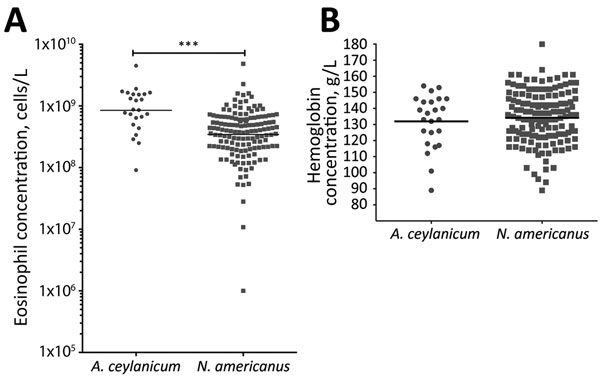Ancylostoma ceylanicum Hookworm in Myanmar Refugees, Thailand, 2012–2015
Elise M. O’Connell

, Tarissa Mitchell, Marina Papaiakovou, Nils Pilotte, Deborah Lee, Michelle Weinberg, Potsawin Sakulrak, Dilok Tongsukh, Georgiette Oduro-Boateng, Sarah Harrison, Steven A. Williams, William M. Stauffer
1, and Thomas B. Nutman
1
Author affiliations: National Institutes of Health, Bethesda, Maryland, USA (E.M. O’Connell, G. Oduro-Boateng, S. Harrison, T.B. Nutman); Centers for Disease Control and Prevention, Atlanta, Georgia, USA (T. Mitchell, D. Lee, M. Weinberg, W.M. Stauffer); Smith College, Northampton, Massachusetts, USA (M. Papaiakovou, N. Pilotte, S.A. Williams); University of Massachusetts, Amherst, Masschusetts, USA (N. Pilotte, S.A. Williams); International Organization for Migration, Mae Sot, Thailand (P. Sakulrak, D. Tongsukh); University of Minnesota Medical School, Minneapolis, Minnesota, USA (W.M. Stauffer)
Main Article
Figure 5

Figure 5. Eosinophil and hemoglobin concentrations in US-bound Myanmar refugees at 3 camps along the Myanmar–Thailand border who were monoinfected with Ancylostoma ceylanicum (n = 24) or Necator americanus (n = 143) hookworm at baseline, Thailand, 2012–2015. Those co-infected with both hookworms or Strongyloides stercoralis, Ascaris lumbricoides, or Trichuris trichiura roundworms were excluded from analysis. Horizontal line indicates geometric mean. Significance was calculated by Mann-Whitney test. A) The geometric mean eosinophil cell concentration was significantly higher in those with A. ceylanicum monoinfection (8.49 × 108 cells/L, 95% CI 5.98–12.0 × 108 cells/L) than those with N. americanus monoinfection (3.44 × 108 cells/L, 95% CI 2.92–4.05 × 108 cells/L) (***p<0.001). B) The geometric mean hemoglobin level of the 2 groups was not significantly different.
Main Article
Page created: July 11, 2018
Page updated: July 11, 2018
Page reviewed: July 11, 2018
The conclusions, findings, and opinions expressed by authors contributing to this journal do not necessarily reflect the official position of the U.S. Department of Health and Human Services, the Public Health Service, the Centers for Disease Control and Prevention, or the authors' affiliated institutions. Use of trade names is for identification only and does not imply endorsement by any of the groups named above.
